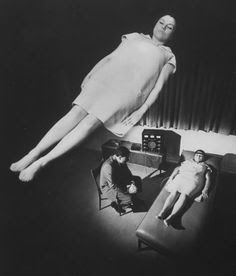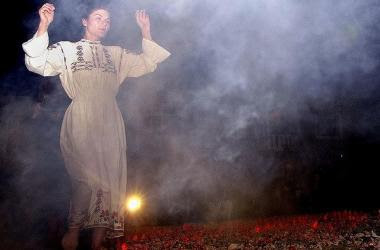Oddball Films presents Strange Sinema 93, a monthly screening of new finds, old gems and offbeat oddities from Oddball Films’ vast collection of 16mm film prints. Drawing on his collection of over 50,000 16mm film prints, Oddball Films director Stephen Parr has compiled his 93rd program of classic, strange, offbeat and unusual films. This installment, Strange Sinema 93: Trance Cinema is an exploration into the cinematic documentation of ritual, trance and altered states. Drawing on rare ethnographic and historic acquisitions from the archives, this program showcases ritualized trance states, powerful healing ceremonies and ceremonial dances from around the world. Films include Margaret Mead and Gregory Bateson’s legendary ethnographic study Trance and Dance in Bali (1937-39), Anastenaria (1970), a rare documentation of surviving Dionastic worship in Greece featuring ritualized slaughter and a breathtaking fire walking ritual, Ma’Bugi: Trance of the Toraja (1973) the powerful physicality of spirit-possession rituals of the Indonesian highlands, where men climb a ladder of knives, Pomo Shaman (1964), a rare record of a female Pomo Indian doctor who enters a trance and cures a patient with the aid of a spiritual instrument, Walbiri Fire Ceremony (1977) showcases a spectacular three-day Australian Aboriginal communal ritual of penance, Himalayan Shaman of Northern Nepal (1966) John and Patricia Hitchcock’s examination of shamanism in the Himalayas including possession and purification, and Tanka (1976) David Lebrun’s remarkable and fierce animated vision of ancient gods and demons in the Tibetan Book of the Dead. Also, pre-show highlights from Land-Divers of Melanesia (1972), Kal Muller and famed ethnographic filmmaker Robert Gardner’s profile of Melanesian men as they attach vines to their ankles, diving headlong from a 100 ft wooden tower in the Naghol land-diving ritual.
Venue: Oddball Films, 275 Capp Street San Francisco
Admission: $10.00 Limited Seating RSVP to RSVP@oddballfilm.com or (415) 558-8117
Web: http://oddballfilms.blogspot.com

San Francisco archivist, imagemaker and curator Stephen Parr, founder of Oddball Film+Video has a long history of presenting and archiving the unusual. Since the 1970s Parr has produced and documented live performances of John Cage, Christian Marclay and The Ramones, screened his signature pop culture montages from the Danceteria in New York to the Moscow Cinematheque. He’s created found footage based films such as Historical/Hysterical?, The Subject is Sex and Euphoria! which have screened worldwide in venues such as The Anthology Film Archive, Jaaga in Bangalore, South India and the Leeds International Film Festival. He curates an eclectic weekly film series-Oddball Films at his archive and is a frequent presenter at film and media seminars and symposiums. He is an active member of the Association of Moving Image Archivists. He has currently completed Laservision, a program of films exploring the history of lasers and holography inaugurating the Science, Art and Cinema series at Miami’s Frost Museum.
Oddball films is a stock footage company providing offbeat and unusual film footage for feature films like Milk, documentaries like The Black Panthers: Vanguard of the Revolution, Silicon Valley, Kurt Cobain: The Montage of Heck, television programs like Mythbusters, clips for Boing Boing and web projects around the world.
Our screenings are almost exclusively drawn from our collection of over 50,000 16mm prints of animation, commercials, educational films, feature films, movie trailers, medical, industrial military, news out-takes and every genre in between. We’re actively working to present rarely screened genres of cinema as well as avant-garde and ethno-cultural documentaries, which expand the boundaries of cinema. Oddball Films is the largest film archive in Northern California and one of the most unusual private collections in the US. We invite you to join us in our weekly offerings of offbeat cinema.



